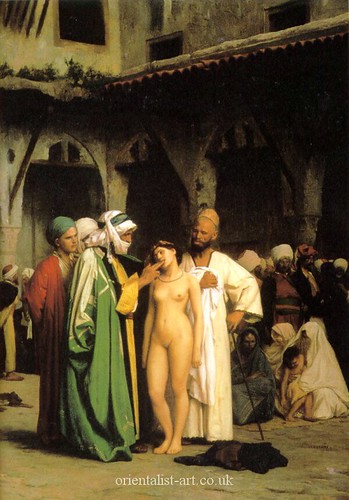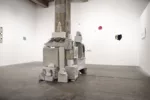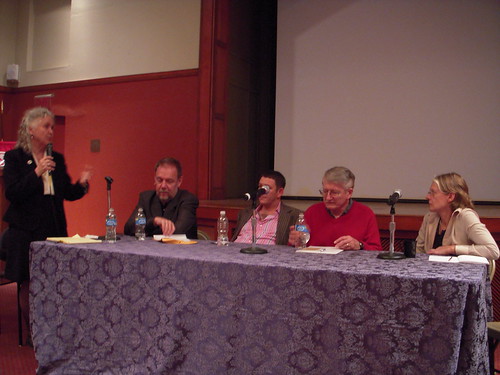
Patricia Hills, David Curtis, Daniel Heyman, Peter Saul, Jane Irish at the Symposium at PAFA, Nov. 1.
Peter Saul‘s exhibit at PAFA was the excuse for an all-day symnposium there on political art earlier this month. But Saul wasn’t the only headliner participating. We also fell for Art Spiegelman‘s bon mots, Laylah Ali’s sometimes veiled wait-wait-don’t-tell commentary about her own work, and Enrique Chagoya’s conflation of art and cartooning. The day also included insights from Philadelphia artists Daniel Heyman and Jane Irish, scholar David Carrier, New York artist/activist Sue Coe and moderator Patricia Hills.
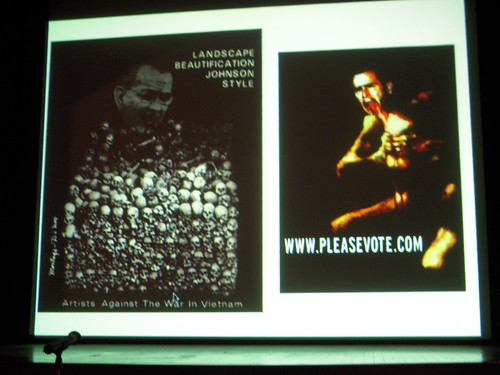
Two political posters by artists. On the right is Richard Serra’s poster which appeared on the back cover of The Nation magazine.
PAFA Curator of Modern Art Robert Cozzolino spoke about the seriousness of content in Saul’s work and said [his] “Vietnam paintings are the most brave anti-war statements of the 20th Century.” Placing Saul in the tradition of 19th century history paintings from PAFA, Cozzolino also invoked the names of 20th century political artists like Ed Kienholz, Faith Ringgold, Leon Golub, Nancy Spero and PAFA’s own Irving Petlin.
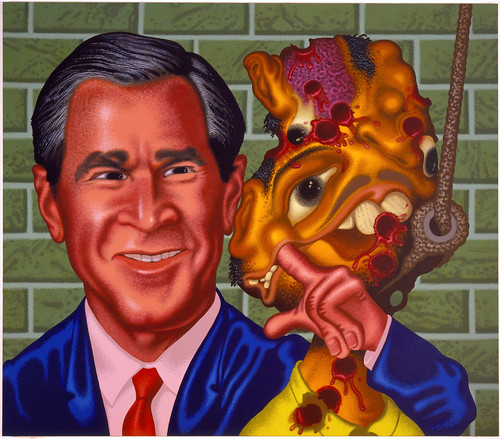
Peter Saul, Bush at Abu Ghraib, 2006; Acrylic on canvas 78 x 90 inches (198.1 x 228.6 cm); Hall Collection.
Cozzolino cleared the art historical record behind Saul’s Bush at Abu Ghraib painting, saying Bush is putting his finger in the victim’s mouth (not in his nose—as stated in the show’s catalog). Saul’s work quotes a Jean-Léon Gérôme painting, The Slave Market. There, a prospective buyer puts his finger in the naked female slave’s mouth to check her teeth. “It’s a classic iconographic symbol of debasement….it widens the [Saul] picture. It’s more than a good joke.”
But Saul himself was not going to let seriousness rule the day. He gave a puckish talk about his career, with deadpan disclaimers about the seriousness of his own motives.
Saul, who came out of ’60s Pop, has the look of a leprechaun, with a twinkle in his eye and a self-deprecating, ironic charm. He said “I’m just a normal person with the usual frailties. (He has three kids, two wives and the second one has been his wife for 35 years.)
His talk was a litany of slippery statements meant to provoke. To wit, he suggested he was lazy, boring, an opportunist, a liar and a shameless self-promoter whose paintings quoted from other artists (DeKooning, Duchamp et al.) to call attention to himself. He posited that his inflammatory Vietnam paintings were a toss off — a career-saving move to grab attention when he saw the war was “on his tv.” And at one point, sounding a little peeved, he challenged the audience to give him better questions to answer!

Peter Saul, Columbus Discovers America. Look at all that blood!
SOME FAVORITE SAULISMS:
“My work is riddled with sexual problems. I think I have the normal sexual problems that people have. I just exaggerate it like I do everything else. I did it to get noticed, then realized it’s why I didn’t get noticed. So what? I still enjoyed making the picture.”
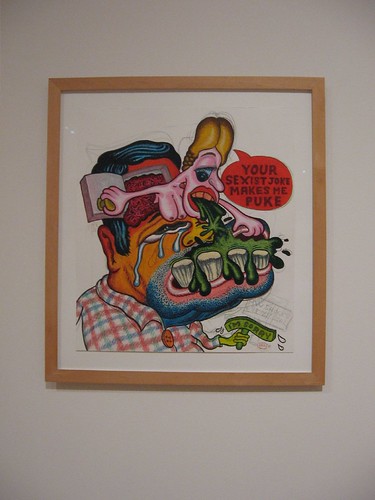
Peter Saul, airing his “usual sexual problems.” The woman is saying, “Your sexist jokes make me puke.” The man is holding a sign saying, “I’m sorry.”
“[Art dealers] all look the same—52, suits, speak two foreign languages. …The one I met, he plopped into my life. He supported me for 27 years…in spite of disappointment and nay saying. …People think art dealers are only interested in money. My feeling is he’s 98 percent of the time a rich person…What he wants is for the artist to create excitement for him. I realized the art dealer wanted some excitement and I just did it. That’s my imagination of them. But I’ve only known four or five.”
“…I’m glad business people control the art world . …intellectuals never gave me anything. The intellectuals are dead as soon as they graduate.”
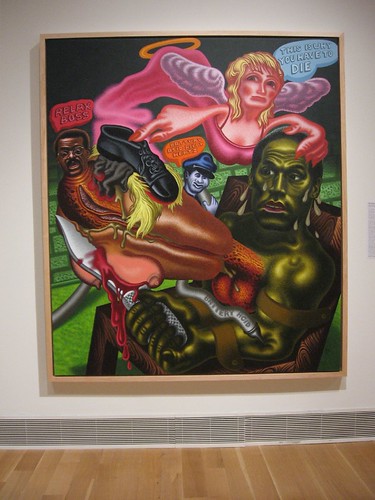
Peter Saul takes on the racially fraught issue of OJ Simpson’s murder trial here.
And, our favorite moment: He compared himself to the faux memoirist excoriated by Oprah Winfrey (whose name he pronounced Opera). The artist of homicidal nightmare paintings has never seen a dead body and cried buckets when his cat was put to sleep! But he’d defend himself on Opera because, “What if a person’s never been to war or is not black…it’s not fair to restrict an Anglo-Saxon person to harmless pictures.”
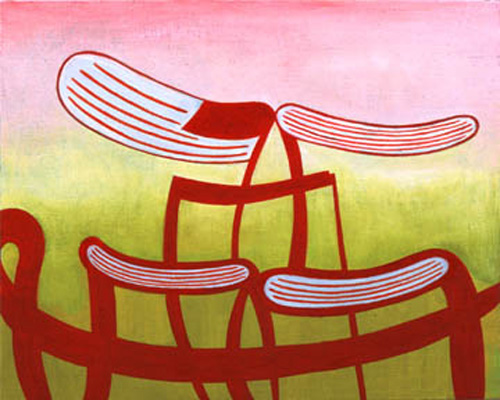
Thomas Nozkowski Untitled (8-44) 2002, oil on linen on panel, 16 x 20 inches, image at http://www.artnet.com/artist/12692/thomas-nozkowski.html, Courtesy Max Protetch Gallery
Scholar David Carrier was pithy no matter what he said and provided some surprise content — several quotes from painter Tom Nozkowski, who in his writings apparently praises Saul’s work for many reasons, including its formal properties. Nozkowski wrote that even Saul’s worst painting is like no one else’s. To this, Saul, surprised, piped up his thanks and said he wasn’t aware Nozkowski said such nice things about him.
Carrier put Saul in great art historical company (Manet, Daumier, Poussin) and compared the artist’s figures to Oldenberg’s soft sculptures or Dali’s melting clocks, saying at one point, “How do these people have sex?”
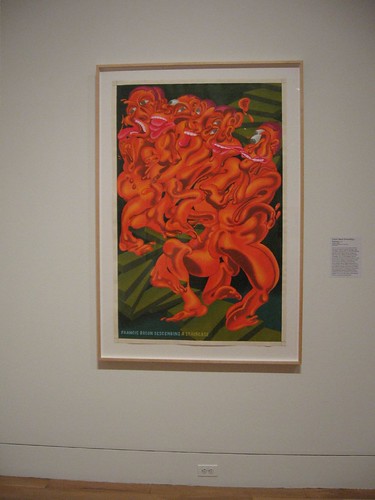
Peter Saul’s take on Nude Descending a Staircase.
Jane Irish and Daniel Heyman each spoke about truth in art and about the importance of words. Irish said that art has the power to create myth. Heyman spoke about the role of words in his portraits of survivors of Abu Ghraib, whom he interviewed in the Middle East in conjunction with a law suit (see posts here and here). “It doesn’t matter what the picture looks like; it’s the importance of the words…
Two issues seemed to rivet people’s attention – the truthiness or falsiness and the function of political art; and the chicken or egg question of what came first, the text or the image. Is art with text a bastard stepchild of the real thing, or a thing of value, in and of itself?
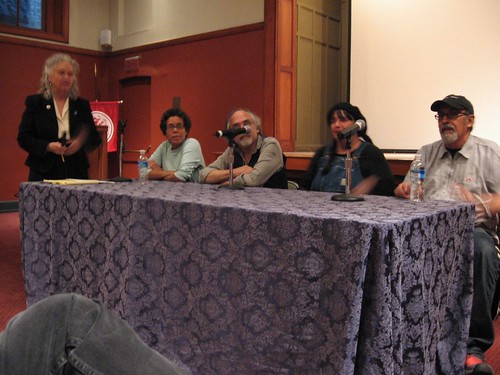
Afternoon panel with Laylah Ali, Art Spiegelman, Sue Coe, Enrico Chagoya
Art Spiegelman, who was named one of the 100 most influential people by Time Magazine in 2005, began his career as a designer of packaging and of Garbage Pail Kids. But his talk went even further back, to some of what led him to underground comics and political art, namely Mad Magazine, which he said he studied the way some kids studied the Talmud. He credited Mad with changing his life. “I believe it must have changed Peter Saul’s life too.” (See Basil Wolverton image from Mad Magazine, below, which Spiegelman showed in his slide show and which is also in the Peter Saul catalog).
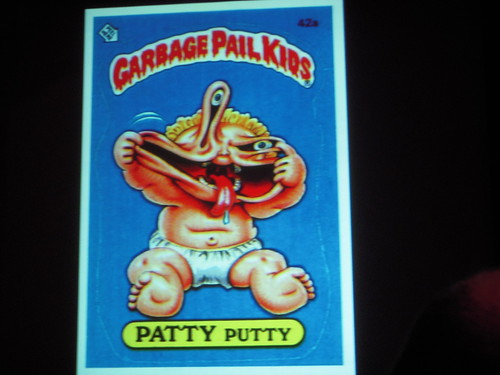
Garbage Pail Kids. Look at that Saul-esque baby!
Spiegelman, a gray-haired but boyishly scruffy chain smoker who sucked on an empty pipe and needed a cig break at one point, looks quite the opposite of the sweater-and-slacks man Saul. Spiegelman has the scholarly air of a New York intellectual. Earnest and passionate, he said things like, “Mad showed us the underbelly of Norman Rockwell America, that monolithic culture. …These were powerful lessons for me.”
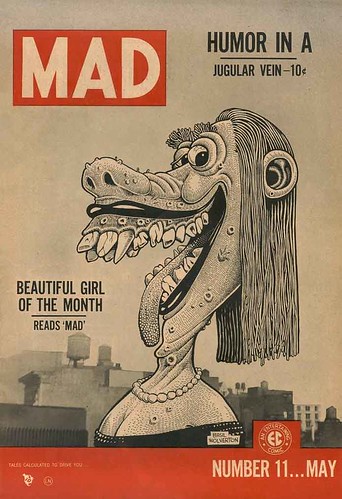
Basil Wolverton’s Mad Magazine cover, which influenced both Spiegelman and Saul.
New York artist Sue Coe, dressed in overalls, her hair in braids, was born in England, next to a slaughterhouse. It was her personal story and her sense of outrage—for abused animals and for abused women prisoners—that dominated her talk.
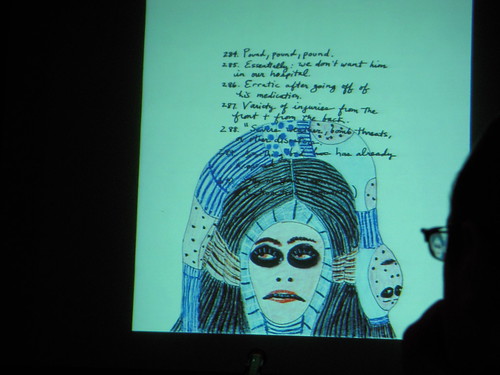
Laylah Ali, slide of some of her new work combining lists of words with imagery.
But Laylah Ali took a quieter approach, hiding her physical presence in unremarkable clothing – actually we remarked how she was dressed like her characters in the Greenheads series—sporty casual. The Williamstown, MA artist, who showed a group of drawings in PAFA’s Morris Gallery in 2006, told us that she wrote her notes for the talk on a vomit bag on the airplane coming into Philly. She held up the bag for show and tell.
Ali doesn’t give a lot away in her work. “Narrative is important in my work but I trust the viewer 70 percent and I give 30 percent.” She admitted her much admired but cryptic Greenheads paintings from the ’80s were personal, political and loaded with family dynamics.
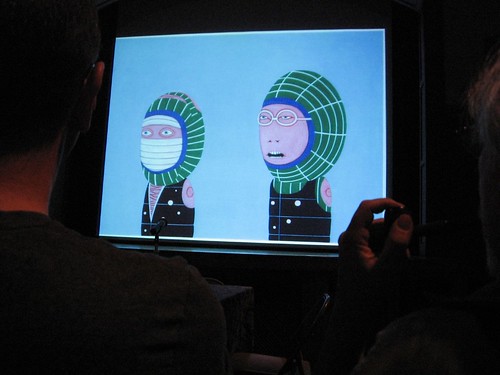
A slide of Laylah Ali’s work, loaded with the personal and political and family dynamics. The figure on the right looks sort of like Ali herself.
“I come from a family where domestic violence was a big part…my father grew up in the Jim Crow south…but it was a family secret. I didn’t know that. I thought my father grew up in Chicago. There were lots of secrets in my family.”
In school she made works reflecting her family’s darker secrets (an uncle who murdered his wife and was executed) but got weird feedback about the works and took a giant step away from the personal. Her newest works involve lists of words to which she adds drawings.
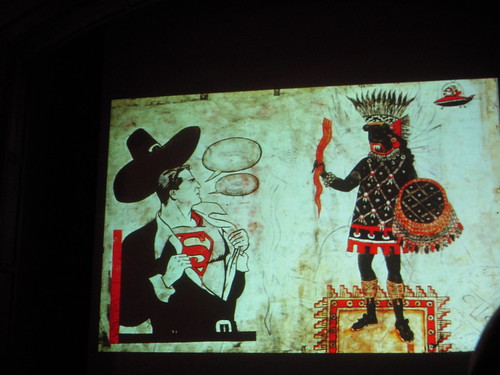
Enrique Chagoya slide. Chagoya and Saul appropriate Superman in their works. We think the right side of the panel shares something of Laylah Ali’s highly costumed characters in her show at PAFA in 2006.
The last speaker, Enrique Chagoya, a former political cartoonist (well, in some sense he still is!), came to the U.S. from Mexico in 1977, with an engineering degree, but then earned degrees from the San Francisco Art Institute (BFA) and Berkeley (MFA). He merges pre-Columbian and Western imagery from art history and popular culture in his politically inflected art work.
Most interesting revelation Chagoya spit out – his father was a very successful detective at the Mexico mint and Chagoya spent a lot of time looking at the collection of confiscated forgery plates of pesos and dollars! “If I can’t make it as an artist, I can make it as a forger,” he said.
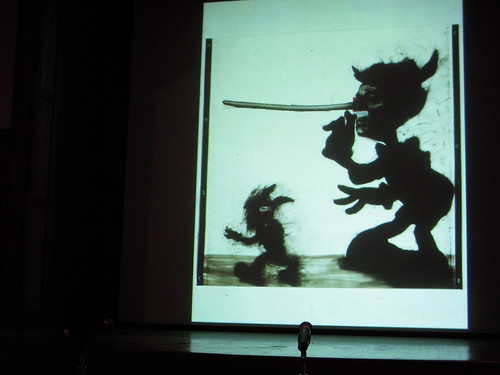
Enrique Chagoya. Nose Job — Ronald Reagan as Pinnochio. “I wasn’t intending to make art, just a cartoon, but I got lots of exhibitions. I didn’t expect to be popular but I got popular.”
We loved his geopolitical take on things. He calls his works – which reference everything from Mayan culture to Goya and Mickey Mouse – “reverse anthropology.” And he explained his MM fixation: “I grew up with Mickey Mouse. I thought he was Mexican. Then I saw the Mickey Mouse Club and said, Oh, I guess he’s not Mexican.”
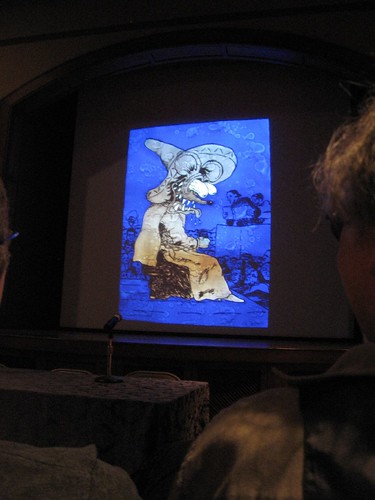
Chagoya slide of Enrique Chagoya work. In this one, you can see the influence of another mouse besides Mickey Mouse–Speedy Gonzalez.
The most ad hoc exchange of the day was between Saul, sitting in the last row of the audience at that point, and Spiegelman, then at the front table:
Saul: Art, do you ever feel when your art is rejected by a magazine…do you want to kill them?
Spiegelman: I hate the word it’s called — “submission”…I quit every six weeks; then I get called back in.
Saul: You seem pretty calm.
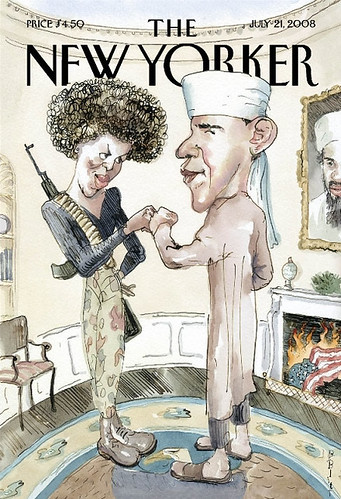
Controversial New Yorker cartoon by Barry Blitt that Spiegelman referred to in his anecdote about his own Obama cover idea being rejected by the magazine.
Spiegelman: I’m on Quaaludes…I have a picture for a New Yorker cover of a dirty White House with blood…mud…and Obama walking in at night, like a janitor. But The New Yorker got freaked from the last Obama cover [by Barry Blitt, so the magazine turned Spiegelman’s down].
Finally, Coe brought real commerce into the discussion, saying she’d brought prints she was selling to benefit the Farm Sanctuary. We perked up at this and bought the last two available for $20 each.


